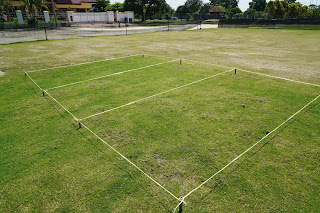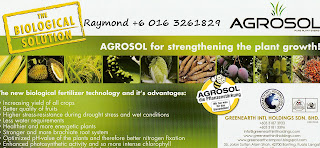 |
| 100% Natural, 100% Organic, 100% Bee Friendly! |
Scientists warn of 'ecological Armageddon' after study shows flying insect numbers plummeting 75%
 |
| After 2 spray, new leafs. |
Had been relying on the supporting documents on AgroSol's web page and was happy to learn that they are 100% organic and natural. Latest certification is Bees friendly. The basic concept of spraying AgroSol, let it absorbed through the leafs and increase photosynthesis is simple enough and should work.
I went around the apartment spraying AgroSol on my own and the landscaping plants as a trial to see if it works. I find that some of the plants have this waxy leafs and the spray just kind of run off. I then remember that we have to add some surfactant / wetting agent.
Found 2 posting in Facebook, someone had tested it on Figs & Mango. It seems that these plants react differently to AgroSol. The Figs reacted to produce more buds. The Mango produce more leafs.
I bought a fig plant for testing of the AgroSol on fig. Am initiating some trials for Durian, Avocado, Turf grass and Rockmelon. Data should be available soon. Trying to contact more commercial people to do trial. Should you have interest, kindly contact me. Am trying to arrange close to Kuala Lumpur first due to logistic reasons.
 |
| Fig, transferred into recycle bag, filled with BioRichField & BioRichar |
 |
| Testing different concentration on Turf grass. |
Method of delivery, getting the AgroSol into the stomata.
My thinking is that delivery pressure and water droplet size affects delivery. Temperature and humidity level too. Adding a wetting agent helps and reduce the absorption time from 2 hours.Wetting / sticking agent help in rainfastness. Absorption is also enhanced by spraying to top & bottom side of the leaf. Different plants have different leaf physiology. Some have waxy coating, some have many small hairs, hindering delivery.
AgroSol's literature indicated delivery pressure of 3 to 4 bar and a nozzle diameter of 100 to 300 microns.
Concentration, different concentration for different plants.
AgroSol's literature indicated 1:66 to 1:266 and just a fine layer. My office suggested 1:400 to 1:600. I am still trying to find out what concentration work best for what plants. Optimizing the concentration, based on plants and stage of growth.
 |
| Start spraying |
AgroSol's literature indicates we can start spraying from the 2 leaves stage. At 10 to 14 days interval. I am in the opinion of optimizing frequency to the stage of growth & types of plants. My initial trials for rockmelon suggested that we need to increase frequency as the growth rate is rather fast (75 days cycle). For these fast growing plants, we can do more (photosynthesis) to more leaves in between the 14 days. I also feel that the current health condition prior to spraying also affects the out come. A plant in not good health shall need to recuperate first before new growth.
 Expecting so data to be available in the coming weeks. Also expecting to do more trials on different plants. Stay tune.
Expecting so data to be available in the coming weeks. Also expecting to do more trials on different plants. Stay tune.#Agrosol #Organic #Natural #BeeFriendly
Tested in Malaysia for #AvocadoFriendly #GrapeFriendly #DurianFriendly#MangoFriendly #RockmelonFriendly #PapayaFriendly #TurfFriendly #FigFriendly



















